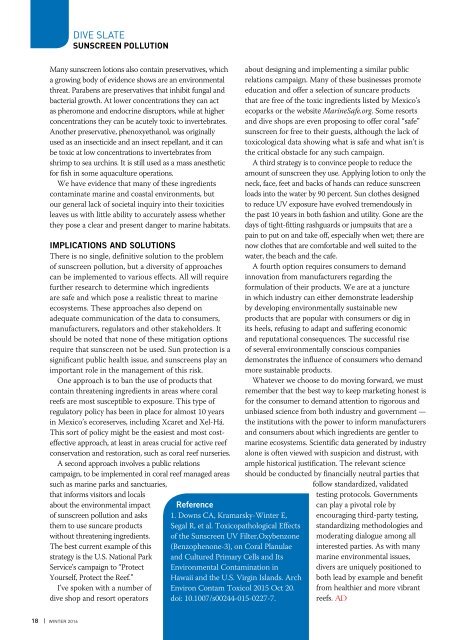AD 2016 Q1
Create successful ePaper yourself
Turn your PDF publications into a flip-book with our unique Google optimized e-Paper software.
DIVE SLATE<br />
SUNSCREEN POLLUTION<br />
Many sunscreen lotions also contain preservatives, which<br />
a growing body of evidence shows are an environmental<br />
threat. Parabens are preservatives that inhibit fungal and<br />
bacterial growth. At lower concentrations they can act<br />
as pheromone and endocrine disruptors, while at higher<br />
concentrations they can be acutely toxic to invertebrates.<br />
Another preservative, phenoxyethanol, was originally<br />
used as an insecticide and an insect repellant, and it can<br />
be toxic at low concentrations to invertebrates from<br />
shrimp to sea urchins. It is still used as a mass anesthetic<br />
for fish in some aquaculture operations.<br />
We have evidence that many of these ingredients<br />
contaminate marine and coastal environments, but<br />
our general lack of societal inquiry into their toxicities<br />
leaves us with little ability to accurately assess whether<br />
they pose a clear and present danger to marine habitats.<br />
IMPLICATIONS AND SOLUTIONS<br />
There is no single, definitive solution to the problem<br />
of sunscreen pollution, but a diversity of approaches<br />
can be implemented to various effects. All will require<br />
further research to determine which ingredients<br />
are safe and which pose a realistic threat to marine<br />
ecosystems. These approaches also depend on<br />
adequate communication of the data to consumers,<br />
manufacturers, regulators and other stakeholders. It<br />
should be noted that none of these mitigation options<br />
require that sunscreen not be used. Sun protection is a<br />
significant public health issue, and sunscreens play an<br />
important role in the management of this risk.<br />
One approach is to ban the use of products that<br />
contain threatening ingredients in areas where coral<br />
reefs are most susceptible to exposure. This type of<br />
regulatory policy has been in place for almost 10 years<br />
in Mexico’s ecoreserves, including Xcaret and Xel-Há.<br />
This sort of policy might be the easiest and most costeffective<br />
approach, at least in areas crucial for active reef<br />
conservation and restoration, such as coral reef nurseries.<br />
A second approach involves a public relations<br />
campaign, to be implemented in coral reef managed areas<br />
such as marine parks and sanctuaries,<br />
that informs visitors and locals<br />
about the environmental impact<br />
of sunscreen pollution and asks<br />
them to use suncare products<br />
without threatening ingredients.<br />
The best current example of this<br />
strategy is the U.S. National Park<br />
Service’s campaign to “Protect<br />
Yourself, Protect the Reef.”<br />
I’ve spoken with a number of<br />
dive shop and resort operators<br />
Reference<br />
1. Downs CA, Kramarsky-Winter E,<br />
Segal R, et al. Toxicopathological Effects<br />
of the Sunscreen UV Filter,Oxybenzone<br />
(Benzophenone-3), on Coral Planulae<br />
and Cultured Primary Cells and Its<br />
Environmental Contamination in<br />
Hawaii and the U.S. Virgin Islands. Arch<br />
Environ Contam Toxicol 2015 Oct 20.<br />
doi: 10.1007/s00244-015-0227-7.<br />
about designing and implementing a similar public<br />
relations campaign. Many of these businesses promote<br />
education and offer a selection of suncare products<br />
that are free of the toxic ingredients listed by Mexico’s<br />
ecoparks or the website MarineSafe.org. Some resorts<br />
and dive shops are even proposing to offer coral “safe”<br />
sunscreen for free to their guests, although the lack of<br />
toxicological data showing what is safe and what isn’t is<br />
the critical obstacle for any such campaign.<br />
A third strategy is to convince people to reduce the<br />
amount of sunscreen they use. Applying lotion to only the<br />
neck, face, feet and backs of hands can reduce sunscreen<br />
loads into the water by 90 percent. Sun clothes designed<br />
to reduce UV exposure have evolved tremendously in<br />
the past 10 years in both fashion and utility. Gone are the<br />
days of tight-fitting rashguards or jumpsuits that are a<br />
pain to put on and take off, especially when wet; there are<br />
now clothes that are comfortable and well suited to the<br />
water, the beach and the cafe.<br />
A fourth option requires consumers to demand<br />
innovation from manufacturers regarding the<br />
formulation of their products. We are at a juncture<br />
in which industry can either demonstrate leadership<br />
by developing environmentally sustainable new<br />
products that are popular with consumers or dig in<br />
its heels, refusing to adapt and suffering economic<br />
and reputational consequences. The successful rise<br />
of several environmentally conscious companies<br />
demonstrates the influence of consumers who demand<br />
more sustainable products.<br />
Whatever we choose to do moving forward, we must<br />
remember that the best way to keep marketing honest is<br />
for the consumer to demand attention to rigorous and<br />
unbiased science from both industry and government —<br />
the institutions with the power to inform manufacturers<br />
and consumers about which ingredients are gentler to<br />
marine ecosystems. Scientific data generated by industry<br />
alone is often viewed with suspicion and distrust, with<br />
ample historical justification. The relevant science<br />
should be conducted by financially neutral parties that<br />
follow standardized, validated<br />
testing protocols. Governments<br />
can play a pivotal role by<br />
encouraging third-party testing,<br />
standardizing methodologies and<br />
moderating dialogue among all<br />
interested parties. As with many<br />
marine environmental issues,<br />
divers are uniquely positioned to<br />
both lead by example and benefit<br />
from healthier and more vibrant<br />
reefs. <strong>AD</strong><br />
18 | WINTER <strong>2016</strong>









